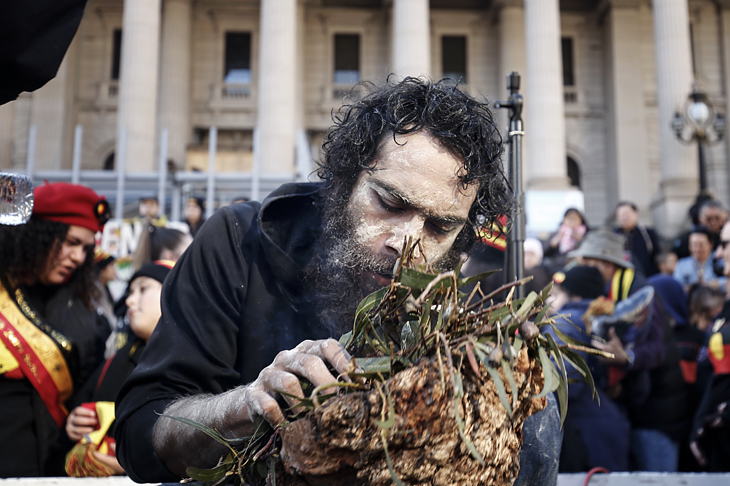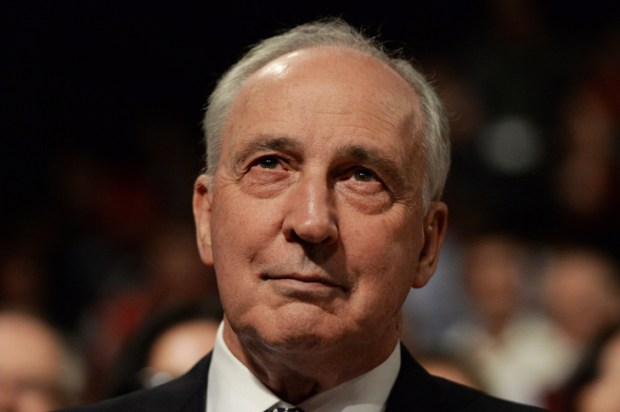Nathan Moran, of the Metropolitan Local Aboriginal Land Council in Sydney, kicked off Naidoc week by criticising the city’s publicly-funded sculptures in Sydney. It was ‘breathtakingly hard trying to feel proud walking around seeing statues of people that my old people have told me have declared martial law on us,’ he told the ABC. Naidoc week is meant to celebrate indigenous history, culture and achievements, yet it’s ‘breathtakingly hard’ not to feel that it’s often a platform to attack non-Aboriginal Australians.
There is no dispute that the colonisation of Australia involved a protracted and at times bloody conflict between Aboriginal people and British settlers, but military authorities under martial law only rarely became involved. Still, that is what Moran focused on, criticising the ‘narrative of only honouring colonial powers and authorities.’ NSW Greens MP David Shoebridge added that ‘the only sanctioned historical figures are essentially white men with the occasional cat or queen thrown in.’ It’s as if the public art in Sydney celebrating indigenous Australia didn’t exist —the forest of trees in the forecourt of the Museum of Sydney; Wuganmagulya and Wurrungwuri at Farm Cove; I STAY at Chifley Square, Yininmadyemi, a memorial to Indigenous people who served in the military, etc.
The ABC also reported that Indigenous astronomy preceded that of ancient Greece and Egypt by millennia and that variable stars, which have only been known in Western astronomy for about 200 years, were described in Indigenous oral traditions that date back two thousand years. Kamilaroi woman and astrophysicist Krystal De Napoli, who made the dramatic claim, also says that Indigenous astronomical traditions recorded supernova occurrences (exploding stars) and that Indigenous astronomers ‘knew’ that the Earth was round although she is sphinx-like as to how she made the discoveries, which were unquestioningly reported by the ABC. Indeed, the ABC proudly announced an ‘Indigenous-focused takeover’ of its homepage, which it appropriately called an ‘ABC Homepage Blakout.’ Australians hoping for a balanced examination of Naidoc would have to look elsewhere, despite the fact that the theme of Naidoc week, ‘Voice, Treaty, Truth’, raises thorny questions. Surprisingly, an ordinary Australian was allowed to ask one on the ABC’s Q&A, seeking the panel’s thoughts on his view that after working and paying taxes for about 50 years, he believed that no person living in Australia today should be entitled to any special benefit or recognition which is based, not simply on need or achievement, but rather on race, or how long their ancestors were here. Shadow Minister for Human Services and Wiradjuri woman Linda Burney was ‘rather surprised’ by the comment and ‘a little saddened by it’ but she cheered up telling the questioner that ‘the truth liberates’.
It is a sign of the times the Naidocrats leading this campaign are seeking to entrench racial exclusion in the Constitution — with all the ugly disputes that necessarily entails about who is, and isn’t, Aboriginal — rather than abolish it. Naidoc claims indigenous Australians need a Voice to Parliament because ‘they have always wanted an enhanced role in decision-making in Australia’s democracy’. Simply participating in the democratic process is seemingly not enough.
The demand for a ‘Voice’ is based on the claim that Indigenous sovereignty has never been ceded, that ‘it co-exists with the sovereignty of the Crown and should never be extinguished.’ This underwrites the demand for a treaty since only sovereign states can sign a treaty and will no doubt be accompanied by a demand for reparations and further rents. An estimated $33 billion was spent by Australian taxpayers on services for Aboriginal and Torres Strait Islanders according to the 2017 Indigenous Report, some 500,000 people, but it’s hard to imagine that will be considered enough. Leaving aside money, however, if Indigenous Australia is a sovereign state which is co-located with Australia, what will be the rights of non-indigenous Australians? Without a ‘Voice’, will they be second-class citizens behind First Nations?
Uluru, home of the Statement from the Heart, seems to give a clue as to where things might be headed. Once the rock that was formerly known as Ayers was returned to the Anangu people, they eventually decided to prevent all Australians from climbing it, despite the fact that earlier Anangu elders had said that there was no problem with climbing the rock and were filmed climbing to the summit with non-Indigenous Australians.
The truth-telling of the Makarrata Commission will assist this process. As Mr Shoebridge told the ABC, ‘Justice for First Nations peoples requires us as a community to tell the truth about how First Nations peoples bravely resisted invasion.’ In other words, Aboriginal violence towards settlers is heroic; settler violence towards Aboriginal people is horrific. It’s all rather odd. The Greens are the nation’s greatest champions of open borders and welcome boat people with open arms but not if those boat people are British soldiers and settlers. In that case it is okay to reject the foreigners with a Trumpian fervour. These accounts of heroes and villains will presumably be liberally mixed with starry-eyed accounts of the wonders of Aboriginal scientific achievements. But don’t worry. Supporters of the Statement tell us that ‘there will be nothing to fear.’ Of course not.
At the opening of the 46th Parliament, Scott Morrison said, ‘Here, 65,000 years of Aboriginal culture meets mere centuries of Westminster tradition,’ as if there was no connection between the Westminster tradition and the history of Britain, which was continuously occupied for almost 12,000 years and intermittently occupied for almost a million years. Perhaps we all need to do a little more truth-telling. We could start by reminding the Naidocrats that all Australians have prehistoric ancestors who have been invaded. Indeed, it was the Roman ‘conquest’ of Britain in 43 AD that brought that great innovation of writing to the British Isles and catapulted the country into the era of recorded history. It had been previously invaded or settled, take your pick, by successive waves of Celts, Saxons, Jutes, Vikings and Normans. On the whole, despite the raping and pillaging, the territorial losses and gains, these invasions and settlements, along with free trade, enriched the culture and prosperity of the people and contributed to that remarkable achievement, the Westminster system. But that there could be an upside to an invasion or settlement is something we’re unlikely to ever hear on the ABC.
Got something to add? Join the discussion and comment below.
Get 10 issues for just $10
Subscribe to The Spectator Australia today for the next 10 magazine issues, plus full online access, for just $10.
You might disagree with half of it, but you’ll enjoy reading all of it. Try your first month for free, then just $2 a week for the remainder of your first year.














Comments
Don't miss out
Join the conversation with other Spectator Australia readers. Subscribe to leave a comment.
SUBSCRIBEAlready a subscriber? Log in